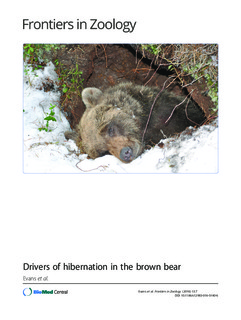Drivers of hibernation in the brown bear
Evans, Alina L.; Singh, N.J.; Friebe, A.; Arnemo, Jon Martin; Laske, T.G.; Fröbert, O.; Swenson, Jon E.; Blanc, S.
Journal article, Peer reviewed

Åpne
Permanent lenke
http://hdl.handle.net/11250/2381139Utgivelsesdato
2016Metadata
Vis full innførselSamlinger
Originalversjon
Evans, A., Singh, N. J., Friebe, A., Arnemo, J. M., Laske, T., Fröbert, O., . . . Blanc, S. (2016). Drivers of hibernation in the brown bear. Frontiers in Zoology, 13(7). doi: 10.1186/s12983-016-0140-6 10.1186/s12983-016-0140-6Sammendrag
Background: Hibernation has been a key area of research for several decades, essentially in small mammals in the
laboratory, yet we know very little about what triggers or ends it in the wild. Do climatic factors, an internal
biological clock, or physiological processes dominate? Using state-of-the-art tracking and monitoring technology on
fourteen free-ranging brown bears over three winters, we recorded movement, heart rate (HR), heart rate variability
(HRV), body temperature (Tb), physical activity, ambient temperature (TA), and snow depth to identify the drivers of
the start and end of hibernation. We used behavioral change point analyses to estimate the start and end of
hibernation and convergent cross mapping to identify the causal interactions between the ecological and
physiological variables over time.
Results: To our knowledge, we have built the first chronology of both ecological and physiological events from
before the start to the end of hibernation in the field. Activity, HR, and Tb started to drop slowly several weeks
before den entry. Bears entered the den when snow arrived and when ambient temperature reached 0 °C. HRV,
taken as a proxy of sympathetic nervous system activity, dropped dramatically once the bear entered the den. This
indirectly suggests that denning is tightly coupled to metabolic suppression. During arousal, the unexpected early
rise in Tb (two months before den exit) was driven by TA, but was independent of HRV. The difference between Tb
and TA decreased gradually suggesting that bears were not thermoconforming. HRV increased only three weeks
before exit, indicating that late activation of the sympathetic nervous system likely finalized restoration of euthermic
metabolism. Interestingly, it was not until TA reached the presumed lower critical temperature, likely indicating that
the bears were seeking thermoneutrality, that they exited the den.
Conclusions: We conclude that brown bear hibernation was initiated primarily by environmental cues, but
terminated by physiological cues.